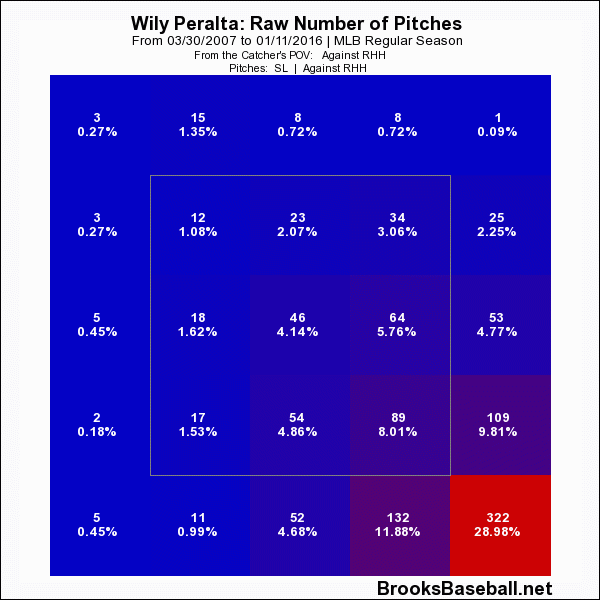From the beginning, Wily Peralta has had stuff. You know the meaning of the term, and if you’ve ever seen him pitch, you can testify to it. This blazing heater…
…plus this diving slider…
…equals, in theory, a dominant pitcher.
As we all know, however, Peralta hasn’t fulfilled expectations. His career ERA- of 103 and DRA- of 110, fitting for a back-end starter, just don’t seem appropriate for someone with this, well, stuff. That arsenal may begin to wane soon (if it hasn’t already), so at age 26, he needs to solve what ails him as fast as he can.
I’ve discussed previously how Peralta hasn’t had much movement on his pitches, which has held him back tremendously. Another, possibly more significant factor has been the presence of a platoon split. Peralta has always floundered when facing left-handed batters — they’ve clobbered a .351 career wOBA against him. He’s limited right-handed batters to a .303 wOBA, but those southpaw struggles have blocked him from taking the next step.
This is where the slider comes in. We know that this offering generally carries a platoon split: Max Marchi estimated that most sliders will perform about a half-run worse (per 100 pitches) versus opposite-handed hitters than versus same-handed hitters. This applies to Peralta, whose slider has killed righties while struggling comparatively against lefties:
| Handedness | BAA | OBP | SLG | wOBA* |
|---|---|---|---|---|
| R | .168 | .215 | .207 | .194 |
| L | .225 | .251 | .391 | .280 |
*This uses the general wOBA formula, meaning the result may differ from his actual wOBA by a point or two.
Peralta hasn’t altered his slider usage by the batter handedness, though — he’s thrown it 27.3 percent of the time to righties and 28.3 percent of the time to lefties. In fact, when he’s notched two strikes on a southpaw, he’s actually relied on it more often (44.0 percent) than in the same situation against their counterparts (38.0 percent). Why would Peralta make this his out-pitch when it hasn’t fooled lefties that well?
In this regard, the slider has still fared much better than his other offerings. Peralta’s four-seam fastball, sinker, and changeup have respective lefty wOBAs of .385, .379, and .364. This incompetence has forced him to lean on the slider as the lesser evil. Changeups typically subdue opposite-handed hitters, so if Peralta can improve his changeup — as he vowed to do last spring — to a usable level, it could replace his slider as the lefty killer he needs.
Until then, Peralta must stick with the slider, which we’ll now return to. Beyond its implementation, the slider also has some bizarre splits. In terms of strikes, called strikes, and swinging strikes, it’s demonstrated a difference in the opposite direction that we’d predict:
| Handedness | Strike% | Look% | Whiff% |
|---|---|---|---|
| R | 56.4% | 18.2% | 13.7% |
| L | 61.4% | 18.1% | 15.3% |
Left-handers have taken the slider for more strikes and have missed it more often, all without sacrificing any looks. How have they demolished it while posting these numbers?
The slider epitomizes the contradictions of Peralta’s platoon split overall. For his career, he’s struck out and walked about the same amount of lefties and righties. The disparity stems from balls in play:
| Handedness | K% | BB% | ISO | BABIP |
|---|---|---|---|---|
| R | 16.4% | 8.0% | .172 | .317 |
| L | 16.4% | 8.3% | .104 | .283 |
Likewise, the slider has seen spikes in its ISO (from .039 to .166) and BABIP (from .250 to .325;) versus lefties. This seems to stem from its location, which Peralta hasn’t successfully shifted by batter handedness:
Peralta has kept the slider low against everyone — 71.4 percent of his righty sliders and 71.9 percent of his lefty sliders have gone to the bottom two-fifths of the zone. Since he’s accumulated the most whiffs and swings there, this has helped him to rack up the strikeouts and avoid the walks. But he’s also placed it inside more often against opposite-handed opponents (33.8 percent in the inner two-fifths) than against same-handed ones (8.2 percent). This has allowed the former to pull those pitches with gusto, making harder contact and thus posting higher BABIPs and ISOs.
To some extent, this seems like an antithetical mix, one that will likely disappear away in the future. Surely southpaws can’t continue to miss so many sliders and batter them when they don’t. And certainly, platoon splits require significant regression when looking to the future. With that said, the overall trends here may not change. Peralta’s slider, like many of its species, darts down and away to righties and down and in to lefties. The common vertical location gives them some shared characteristics, while the horizontal differences establish its platoon split — just as they do for many slider-heavy pitchers.
As a whole, the good outweighs the bad for Peralta’s slider. That stuff has created a healthy amount of whiffs and a good deal of grounders, leading to an overall wOBA of .238 off it. Worth 9.1 runs according to FanGraphs, it’s served him better than any other pitch in his repertoire. Still, it hasn’t performed at the level that it should have — just like Peralta himself. Only by mastering this pitch can he take down lefties and become the top-notch pitcher that he should be.

